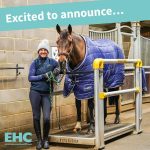- TENDONS AND LIGAMENTS
- MUSCULATURE
- HEALING OF INJURIES
- BONE DENSITY IMPROVEMENTS
- JOINT PROBLEMS
- NAVICULAR
- TENDON INJURIES
- MUSCLE TREATMENT
- SKELETAL PROBLEMS
- URINATION
- COLIC
- VITAFLOOR AS TRAINING EQUIPMENT
- KNEE PROBLEMS
- HOOF PROBLEMS
- SWELLINGS AND INFECTIONS
- PREVENTATIVE TREATMENT DIGESTION
- UNDIAGNOSED PROBLEMS
- GENERALLY STIFF HORSES
- LOOSE BONE PARTS IN FETLOCKS
- FETLOCKS
Example 1: 11-year-old quarter horse
History: Moderate tear of the medial collateral ligament of the right front coffin joint.
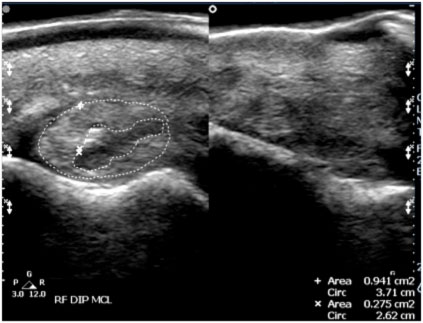
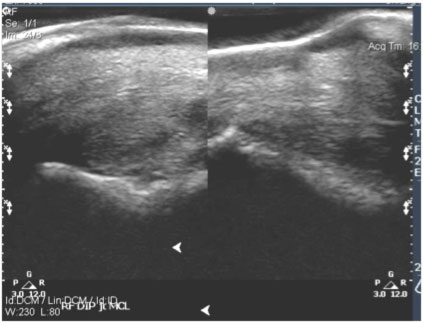
Left image: Sonogram of medial collateral ligament of right front coffin joint, showing enlarged cross-sectional area and a fresh-appearing core lesion.
Ultrasound Impressions: Image on the right was taken 3 months after image on the left and according to the veterinarian it shows reduced effusion and reduced synovitis in comparison with the previous examination. He stated that the lateral collateral ligament was normal and there has been a decrease in inflammation in the coffin joint and good granulation in the core lesion of the medial collateral ligament. Horse was treated twice daily on the Vitafloor.
Example 2: 4 year old thoroughbred
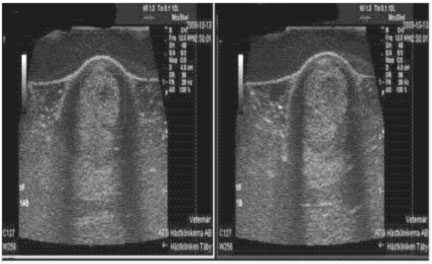
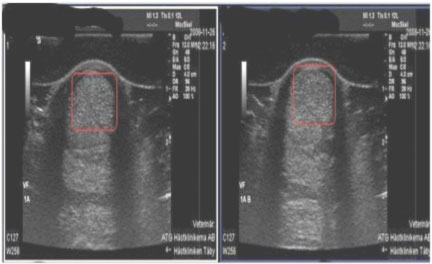
Ultrasound Impressions: Image on the left shows a tendon injury. The series of images is taken over the course of 6 weeks, illustrating a steady improvement. At 6 weeks you can see healing was complete. This horse was treated for this injury twice daily on the Vitafloor.
As mentioned in the section on injuries, we have seen muscle improvement after treatment using Vitafloor. We believe that, with regular treatment, horses will have considerably less chance of suffering from muscular problems.
Navicular bone damage, calcification of the short pastern bone and damaged fetlock joint.
Iravit, Show-jumping horse
The horse had previously had several injections in the fetlock and had been abandoned by one owner after showing lameness in walking. He received Vitafloor treatment twice a day for one month and is reported as being fit and functioning very well.
Two girls shared ownership of Iravit. There were so many problems with the horse that one of the owners had given up. We asked if we could place the horse on Vitafloor, and after one month of daily treatment on Vitafloor, Iravit was back in good form and was able to train again.
After having been written off, he has since been sold to a new owner. Iravit and the new owner have competed in show-jumping events, and it is a pleasure to see that this magnificent horse is again able to assert itself in high-level competition after four years away from the arena. Iravit retired in 2000.
Example: 13-year-old Arab.
History: This horse was diagnosed with moderate to severe Bone Fragility Syndrome (BFS) or Silicosis in April 2012 at UC Davis. She was given an injection of the trial drug Zoledronate which is believed to stop the progression of the disease. She was to be retired from riding due to the risk of musculoskeletal trauma because of the loss of bone density. Her owner brought her to a rehab facility on June 1, where she was treated twice daily for half an hour on our built-in Vitafloor vibrating stall unit, as well as twice daily half an hour on the eurowalker, and turn out whenever possible. She returned to UC Davis in October for her follow up Scintigraphy and below are the results. She was no longer lame and her overall fitness and condition was better than ever. The radiologists were amazed by her improvement, and she was given the all-clear to go back to work! When compared to another horse with a milder case who was treated with the same drug at the same time, that horse’s bone scan showed no worsening but no change, whereas this mare treated with our Vitafloor showed remarkable improvement.

Impressions: Images were taken at UC Davis and on the left are the first bone scan results of the ribs and scapula, and the images on the right were taken 6 months later showing clearly the improvement.
After gradually decreasing the vibration therapy, this horse has now returned home where she is back under saddle and doing well.
This is a serious problem among racehorses. The primary and secondary causes of joint problems is topic that is a much discussed. Good coordination skills, strong and supple muscles, and healthy tendons, ligaments and skeleton result in fewer or no problems with joints and joint fluids. Regular use of Vitafloor can offer significant benefits in these areas.
Example: 7-year-old Dutch Warmblood.
History: This horse was suffering from severe navicular disease as a 6-year-old, was extremely lame and was given up. As a last resort the horse was put on the Vitafloor twice daily initially and on improvement, reduced to treatment once a day.


Impressions: Photo on the right was taken 14 months after photo on the left. According to the veterinarian, the number of ‘lollipops’ has reduced (visible on originals on HD screen).
Leave a Strip, Warm-blooded trotter
Trainer Ole Johnsen
The injury started with haemorrhaging along the suspensory ligament. The tendon was torn but not completely. The horse received treatment for one month on Vitafloor, and during this period had only walk training. Leave a Strip was then examined by a vet and it a great improvement was found in the injured area. After this, the training was gradually increased and the horse is now fit and is training for race.
Conquistador, Racehorse
Trainer Bendik Bø
Conquistador came to Bendik Bø`s stables in August 2006 with a tendon injury and one poor fetlock. He then had a 56 handicap. Conquistador has been treated on Vitafloor twice a day continually since he came to us. We trained him for two months before his first start for us, when he finished third. He then raced through the entire winter and kept fresh and sound. From the time we got him into our stable he has been placed in all his races and has earned 11.000 Euros.
Sugar News, Warm-blooded trotter
Trainer Arthur Bø
Sugar News had a torn toe extensor tendon in the hind leg. The tendon was sewn back together, and he was then treated daily on Vitafloor. He was reported fit after two months. The vet was surprised to see such quick and complete healing. Since then, Sugar News has entered several races with great success.
River Run, Gallop horse
River Run developed a large bow on a superficial flexor tendon during a morning gallop. He was only walked for five weeks after this incident. He began tests at the Swedish Agriculture University in March 2004. Before treatment, an ultrasound scan of the tendon was performed, and the veterinary Gøran Sand and Hans Brostrøm clinically examined him. The ultrasound showed minimum 50% damage (destroyed fibres and tissue) in the superficial flexor tendon. River Run began treatment on Vitafloor with 13 sessions of 30 minutes for 12 days. A new ultrasound scan showed great improvement. Sand and Brostrøm, the veterinarians, regarded the healing process as sensational.
Celladone Express, Gallop horse
Celladone Express had an 18-month-old tendon injury, with 50% destroyed fibres and tissues. An ultrasound showed great progress following 14 days of treatment at Uppsala with only Vitafloor and box rest. He then travelled to Norway for training and treatment. Following one month and three weeks standing in the box he managed one hour and 15 minutes striding. He then went back to Uppsala and an ultrasound showed that the tendon was 100% healed.
Conclusion: These horses had considerable tendon injuries. We have also seen noticeable healing on other superficial flexor tendon injuries.
Vitafloor stimulates and trains the muscles in such a way that the muscles are able to tolerate more work so that the horse is less susceptible to injuries in the bones, tendons and suspensory ligaments.
Forearm muscles are a somewhat overlooked muscle group, and this is strange as all the tendons on the bone have their own muscle that is attached to them in the underarm. This muscle receives much stimulation and training during Vitafloor treatment, and gives improved shock absorbency during landing.
Tests on humans have shown that treatment with whole-body vibration can increase bone density by up to 20%. Treatment with vibration is the only treatment that has a documented effect on osteoporosis (brittle bones).
We have treated several horses following surgery to the pastern bones, and these have shown progress with lasting positive effects.
Urination and the circulation and uptake of fluid is vital to a horse’s health and well-being. We often see that after treatment on Vitafloor, horses drink water and urinate. This is a good indication that the horse’s cleansing functions are working properly.
As we have mentioned, Vitafloor treats the horse as a whole, improving its general health, physical condition and mood.
Stig H. Johannson, the Swedish trot trainer, has said that after installing Vitafloor he no longer has problems with horses suffering from colic. He uses Vitafloor frequently on horses that trot badly and have poor coordination on the track. Aside from the obvious benefits, he is also very pleased with the Vitafloor’s effect on more indefinable problems. In summary he is delighted with Vitafloor’s effects and results.
Tests on humans have shown that whole-body vibration has a training effect on muscles. Muscles undergo constant minute changes to their length, and this results in a training effect. Tests have shown that just 10 minutes of daily treatment over the course of 10 days produces a significant increase in muscular power.
We have seen an overall positive effect on horses that we have treated on Vitafloor. They are considerably faster and have more spring in their step. Trotting horses become more trot-reliable.
We, and many of the people we work with, have seen that horses treated on Vitafloor and on box-rest for longer periods, do well and look healthier. These horses start training more easily and have a higher level of base condition than normal. This is a consequence of increased blood circulation.
Vitafloor helps horses to becoming more flexible and supple. This has a positive effect when the horses warm up before races, and they use less energy in finding the trot.
Cassio, Show jumper.
Owner Anne Geelmuyden
Cassio had knee problems in the left foreleg with the lower outside knee joint. The owner was near to giving up on the horse after innumerable injections. He had chronic inflammation in the tissue and tendons on the outside of the joint. Cassio was treated on Vitafloor for about a month, and made swift progress. He left our stables after a month, having been reported fit. He is now in full training for the new season.
Equip Hill, Racehorse
Trainer Bendik Bø
Equip Hill was a very promising three-year-old, but hung right and had problems with his right hind leg. We got him in training in the spring as a four-year-old. We treated him continually on Vitafloor once a day and he showed good progress that season.
He started 12 races as a four-year-old and won over 20.000 Euros in prize money. He improved the next year but needed continual treatment on Vitafloor to stimulate the hind leg and promote spinal activity. He won his second start in 2007 and put three straight wins under his belt. Among other races, he won the Valley Chapel Memorial along with 40.000 Euros in prize money. He started his fourth season with a timeform rating of 79 and ended that season with a rating of 108. In total, Equip Hill earned more than 1.4M Swedish krona. It has been a fantastic transformation. Tragically Equip Hill died from acute appendicitis on his journey from Germany to Sweden.
Ohio, Show jumper.
Owner Per Ivar Fritzen
Ohio was feed poisoned at a young age and has bad circulation in all legs. He had many sores and tender joints, hoof soles and sole depressions. He also had deep- haemorrhaging hoof cracks on both forelegs. We started Ohio treatment on Vitafloor in September 2005 and he gradually improved. The sores are gone and the hoof crack has started to heal. Prognosis for Ohio is looking very good. Ohio is back home with his owners and is in great shape.
Example: human with swollen leg after surgery.
History: The photos show heat scans 4 months after surgery on the left leg. The leg was still very swollen and painful with little improvement. You can see the excess heat in red (scale in degrees Celsius). After just 2 treatments on the Vitafloor of 5 and 10 minutes each (with a 20 minute break in between), you can clearly see the drop in temperature. After several weeks of treatment this person was pain free, able to go back to work and his leg was normal again. Yet another illustration why we believe the Vitafloor to be a good tool for treating laminitis amongst other things.
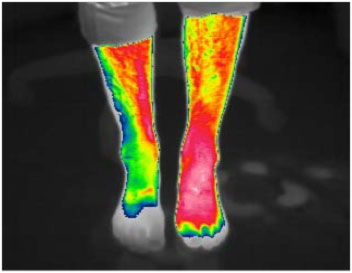
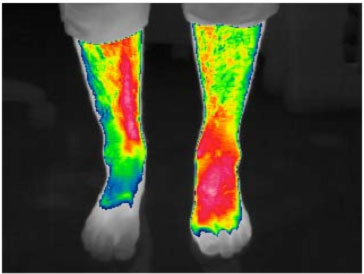
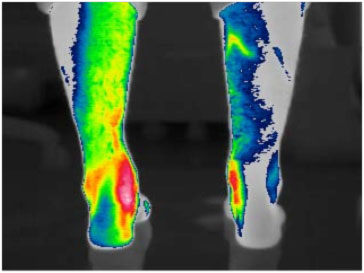
20 minutes break
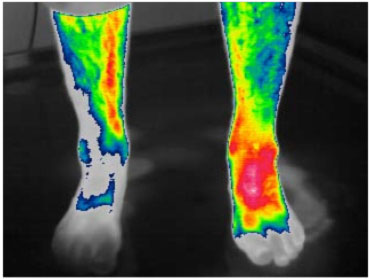
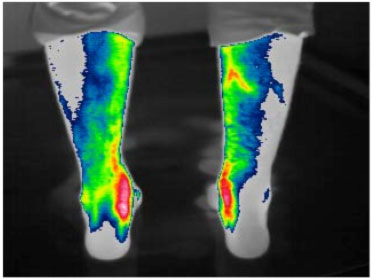
Horses treated on Vitafloor have been shown to maintain a healthy digestive system. Vitafloor increases the blood circulation in the intestines, thus improving the digestion of food.
To date, there have been no problems with horses suffering from colic following treatment. In fact the opposite holds true. Horses in the early stages of colic have, without exception, been cured after 30 minutes of treatment on Vitafloor. However, we always recommend that a vet be contacted if a horse has colic.
Relampago Plus, Racehorse
Trainer Bendik Bø
Rempalago Plus came to Bendik Bø`s stables in August 2006 with non-specific mental and physical problems. He had a nervous disposition and was out of shape. We began treating him twice a day on Vitafloor and then reduced this to once a day. He made his debut for us in with a third place, beaten by a length, and has since increased 12kg in handicap, from timeform rating of 78 to 103. He is now fresh and sound and is listed as one of the best sprinters in Scandinavia.
Moe Odin, Cold-blooded trotter
Owner Stable 17H
Moe Odin came to our stables in August 2004 and was ruled out from further race activity. He had been treated by many experts in Sweden and Norway, none of whom could define exactly where the problem was.
Moe Odin has an enormous gait and needs everything to function well in order for his trot to be in harmony. The root of the problem could not be found, so treatment was difficult. When he came to our stables we immediately noticed this and we were of the opinion that the problem could be seen both at the front and rear. We immediately started treatment using Vitafloor, and at the same time started training the horse.
We quickly noticed progress in the gait, and were then able to gradually increase the training schedule. In the middle of October, Moe Odin was in hard training and he debuted on the racetrack on 4 December. In November he was checked by a vet and showed zero on the bend test (compared with 2 degrees when he came to us). The hind gait was also very good.
Many people think that he is now well and has regained his magnificent gait and suppleness. Seven starts after his comeback he has had five victories, a second place and one fourth place.
Moe Odin continued training at our stables and was treated on daily on Vitafloor until 28 March, when he was moved on to the Spang-Berg Stallion Station for the breeding season. In 2005 and 2006 Moe Odin was the biggest earner in Norway among older cold- blooded trotters. He has earned 270.000 Euros since his comeback and has set a new personal record of 19.6 seconds during the 2005 season. In 2007 he gave Sweden’s cold- blooded trotter king Järvsøfaks a good run for his money.
Voje Best, Cold-blooded trotter
Owner Stall Heigar
Voje Best could not trot at all and had undiagnosed problems. He received intensive treatment two to three times a day and trained at the same time. He gradually improved and after three months he strode in at a fantastic 1.35 in a routine race. This is excellent considering that Voje Best had not entered a race for two and a half years. He went back to his owner in May 2005, which is an excellent result for a horse that could not function at all before being treated on Vitafloor.
Moe Sigyn, Cold-blooded trotter
Owner Tor Martin Moe
Moe Sigyn had very stiff muscles, especially in the right shoulder, and was also slightly nervous during track races. She was treated for one month on Vitafloor and also had some sporadic treatment after a break. She has preformed well following the treatment, with a fourth-place finish at the Mare Derby in 2005. She has now been put out for breeding and was mated in spring 2006.
Moe Argr, Cold-blooded trotter
Owner A. Grønheim
Moe Argr was suffering from knee problems, muscular problems and bad motor control. He also cheated in his trot. He came to our stable in June 2005 and was treated twice a day for about three months. He gradually improved, underwent a veterinary examination and had a zero bend test. He went home to his owner in September 2005 and has achieved good results during the autumn and winter season of 2005/2006.
Robis Ingo, Warm-blooded trotter
Trainer Stig H Johansson
Robis Ingo had very stiff muscles and moved awkwardly, with unidentifiable problems. Stig H Johansson noticed a marked improvement after the horse had been treated on Vitafloor. The horse is now functioning very well.
Augusta Bell, Warm-blooded trotter
Trainer Stig H Johansson
Augusta Bell struggled greatly with muscle problems and moved in an awkwardly. She has been treated for a period and her movement improved gradually. The horse is now functioning very well.
Bit Noble, Racehorse
Trainer Pia Höiom
Bit Noble had poor front fetlocks and had very stiff and sore muscles. The horse started treatment on Vitafloor in summer 2002 with precise results. The fetlocks functioned well and the horse is no longer stiff and sore. The improvement continued during the 2003 season. Bit Noble is a horse that has shown that he is highly receptive to treatment on Vitafloor in maintaining good health.
Conclusion: These are just a few examples of horses with particular problems. We also have many other horses that have shown considerable improvement in muscle flexibility.
The unique strength of Vitafloor is that it treats the whole horse.
Guappa, Racehorse.
Trainer Pia Höiom
Guappa started to race as a two-year-old but suffered from loose bone fragments in both front fetlocks. He was considered to have poor skeletal quality. He was operated on and was later treated on Vitafloor. Since then, he has suffered no further skeletal problems, has begun racing again and has won races.
Waquaas, Racehorse.
Trainer, Bendik Bø
Waquaas is one of the best sprinters in Scandinavia and has won significant prize money during his career. However, he had a poor year at the age of nine and was more or less written off.
When we took him on he had a minor fetlock problem, was stiff in his muscles, ill tempered and not keen to train. We treated him on the Vitafloor twice a day continually. Subsequently, as a 10-year-old in 2006, he secured three victories against the toughest competition, defeating the best sprinters in Scandinavia. It was a sensational comeback.
He continued to be fresh and sound for the entire season. Waquus retired in 2007.
Have a question? Give us a call on +44 (0)1458 251300


